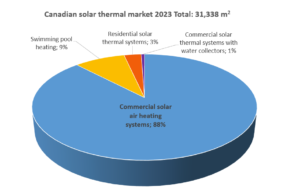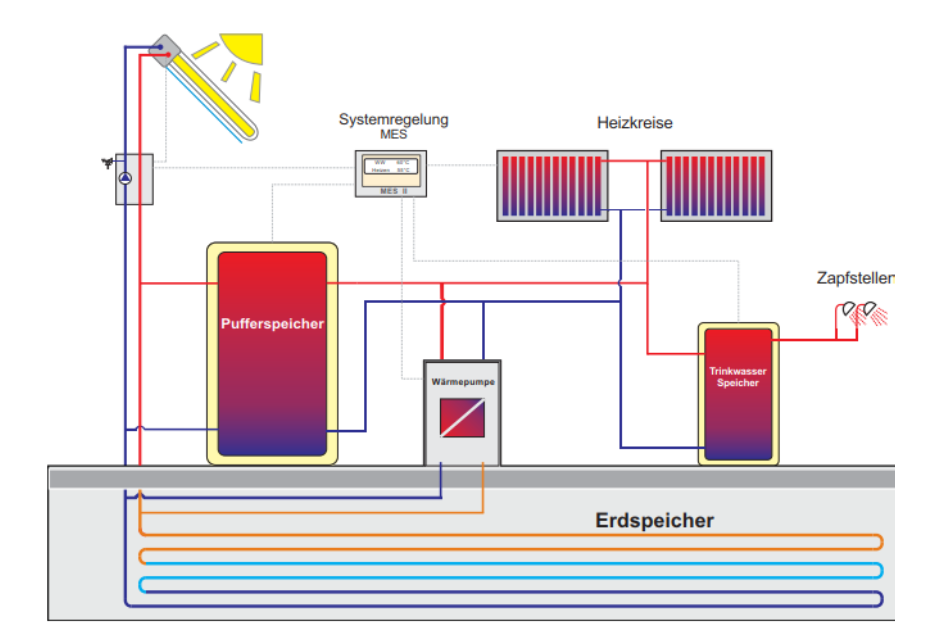
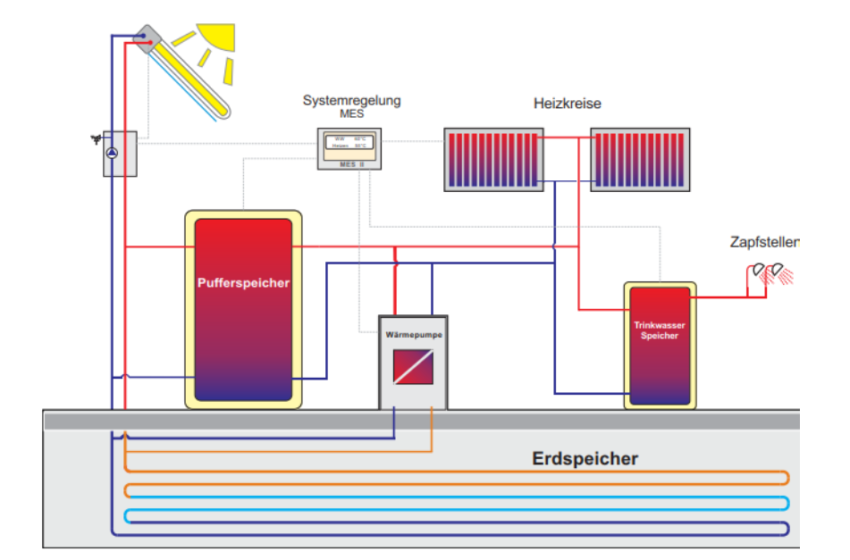
Emission-free heat supply for new building area in Austria
For an emission-free energy supply for new and existing buildings on industrial wasteland in Reutte, Tyrol, Austria, the project developers are using PVT collectors. The Zero Emission Building Design concept of the Austrian company Simona Alexe – greenixcloud convinced the investors. They want to build a new commercial, industrial and residential area on the 120,000 m2 site starting in the fourth quarter of 2022. In addition to the PVT field, central components of the heating concept include the cold district heating network as seasonal storage and a 45,000 m2 underground brine storage.
Figure 1: Simona Alexe – greenixcloud GeoSolar2.0 system architecture
greenixcloud specialises in developing emission-free energy supply concepts for trade and industry, which the company then implements with a network of technology suppliers according to Zero Emission Building Design. PVT collectors are playing an increasingly important role here, as they simultaneously provide green electricity and green heat for the customer. “Due to the growing importance of heat pump systems and electric mobility, developments are clearly moving in the direction of PVT collectors and we are also increasingly using them due to the flexible design possibilities,” explained greenixcloud’s Project Manager Heinz Peter Stoessel. “We only work with investors who are committed to carbon neutrality.”
Investors commit to climate neutrality
In the case of the project in Reutte, this is the current owner of the majority of the site, Liegenschaftsverwaltung Reutte GmbH, a subsidiary of Linz Textil Holding, which used to operate a spinning mill there. It has committed itself to selling the land only to investors who are willing to implement the Zero Emission Building Design concept and to install PVT collectors on their roofs and connect their buildings to the cold heat network.
“In our project developments, we rely on our long-standing GreenTec partners in research and development and as suppliers of the key components. As a result, it is also possible to offer investors a 15-year efficiency guarantee for a sustainable, future-orientated renewable energy system”, Stoessel added. In addition, the Austrian Climate and Energy Fund supported a feasibility study to develop the optimal use of PVT in combination with the cold district heating network.
Concept for emission-free heat supply
greenixcloud took the local conditions into account in the concept development. As the property is located in a gypsum karst area, it is not possible to use the groundwater as a heat source for the heat pumps through boreholes. The function of the seasonal storage and the heat source for the heat pumps is therefore taken over by the cold district heating network. It is operated at temperatures between 4 and 25 °C. This results in only low losses in the pipe network.
The energy supply is ensured by PVT collectors on all the roofs of the buildings. The buildings all have three different heat storages: one buffer tank for hot water and one for space heating supply as well as an underground brine storage under the foundations. Heat pumps in the buildings support the supply. They use the warm side of the cold district heating network or the underground brine storage as a heat source and raise the temperature to the required level.
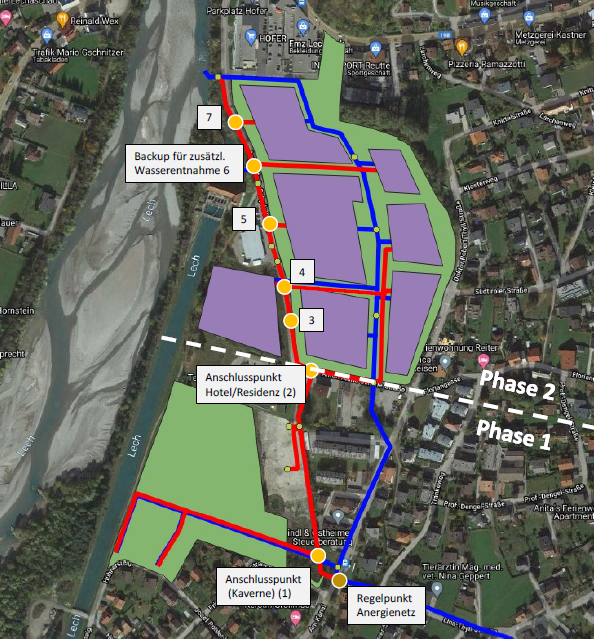
Illustration of the cold district heating network with connected buildings. The network consists of two pipes with different functions and temperature levels. The warm side (orange line) takes in the PVT heat and serves as a source for the heat pumps. The cold side (blue line) is used for the discharge of roof and surface water and takes over the water return function of the heat pumps.
Source: greenixcloud/AEE INTEC
Project data for the entire new development area on the site of the former Link Textil Holding AG spinning mill in Reutte:
- Total area: approx. 120,000 m2
- Heated and cooled area: 90,000 m2
- Glazed and insulated PVT collectors
- PVT area: 35,860 m2
- Usable solar yield: 17,136 MWh/a
- Electricity generation PVT collectors: 8,030 MWh/a
- Heat pump capacity: 3.5 MW
- Area of underground brine storage: 45,000 m2
- Annual coefficient of performance of heat pumps for space heating: 5.2
Cold district heating network as seasonal storage
“An important building block for the successful realisation of an emission-free neighbourhood is the development of different types of storage and the intelligent networking of thermal energy users with each other,” said Stoessel, describing the challenge. Dynamic simulations by greenixcloud have shown that the commercial buildings will largely cover their own thermal energy needs.
An intelligent control system first distributes the heat from the PVT collectors to the buffer tanks for hot water and space heating. When this storage is full, the control system ensures that the long-term storage such as the underground brine storage and the cold district heating network are charged with heat and thus regenerated.
The different storage facilities are charged and discharged according to a yield-orientated system control and are the basis for high solar coverage and self-sufficiency levels in this neighbourhood. The different temperature levels in the individual storage tanks pose a particular challenge. This is solved by prioritising or cascading according to the system temperatures. For this purpose, the buildings and energy systems communicate with each other on the basis of intelligent control components.
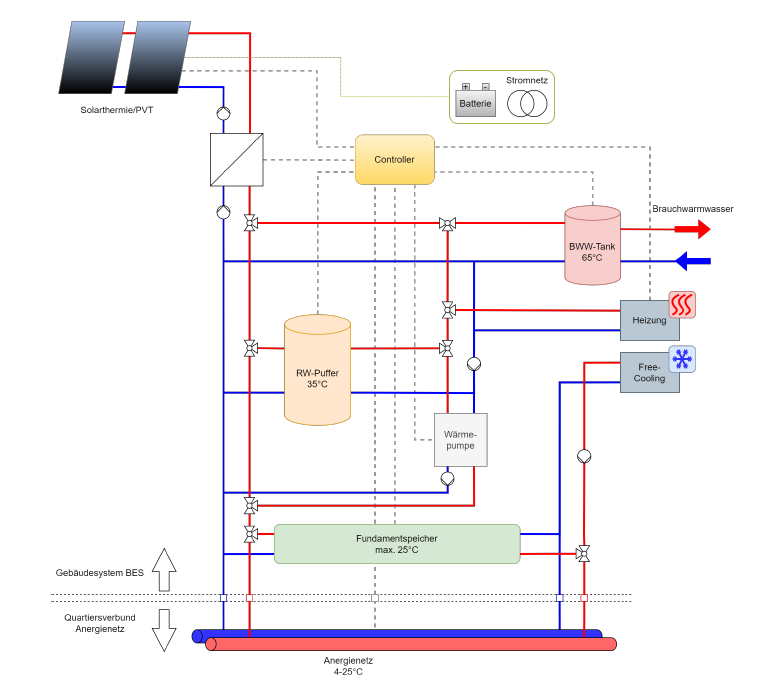
Intelligent control in the building energy system regulates the loading of the storage tanks as well as the heat output into the cold district heating network. Source: greenixcloud/AEE INTEC
Organisations mentioned in this news article:
Simona Alexe – greenixcloud
AEE INTEC
Linz Textil Holding


